14th December, my last blog/update of the year, and until late January. Plenty to read and digest here, and I shall send another newsletter in early January.
I hope you enjoy the new website. We have reorganised it a lot, so for existing users it may take a while to find a few things. Just now the forum needs more work and is out of action until Weds 19th December
Thanks for your interest this year, I hope that harvests are good. I have enjoyed wonderful results in 2018, both in the no dig garden and in my teaching work. Keep an eye out for my new online course, which I am creating now for release by February.
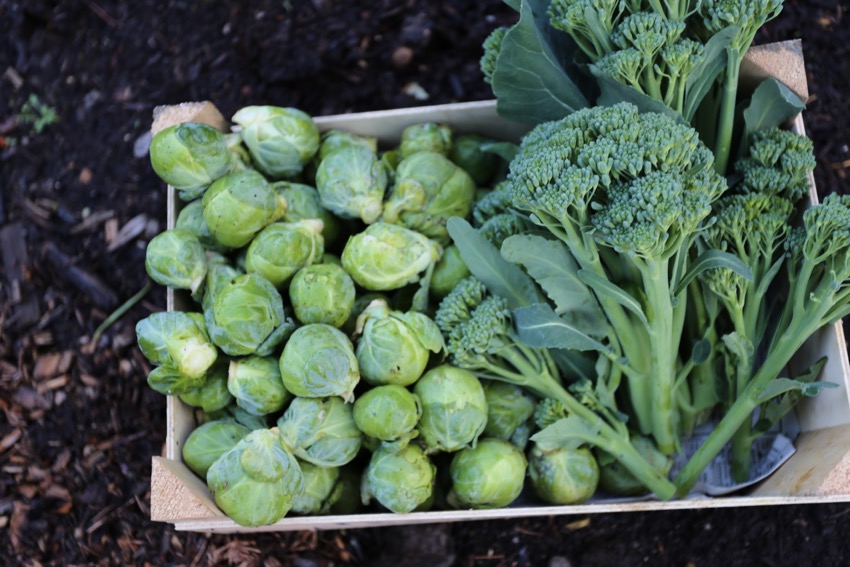
Brussels sprouts are normal in December, broccoli less so, this is Kaibroc still cropping, sown late July planted late August
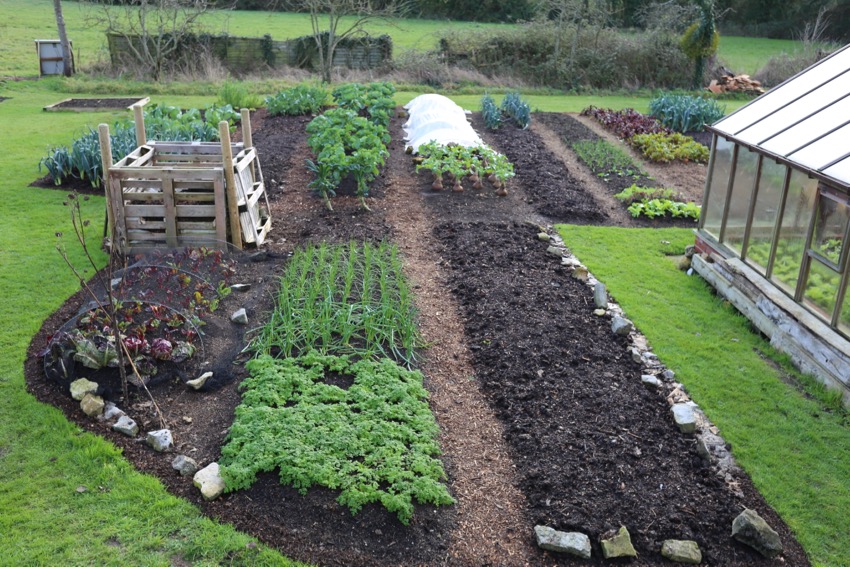
E end of Homeacres, paths mulched with 8 month woodchip, cleared beds have compost, chervil in foreground then spring onions
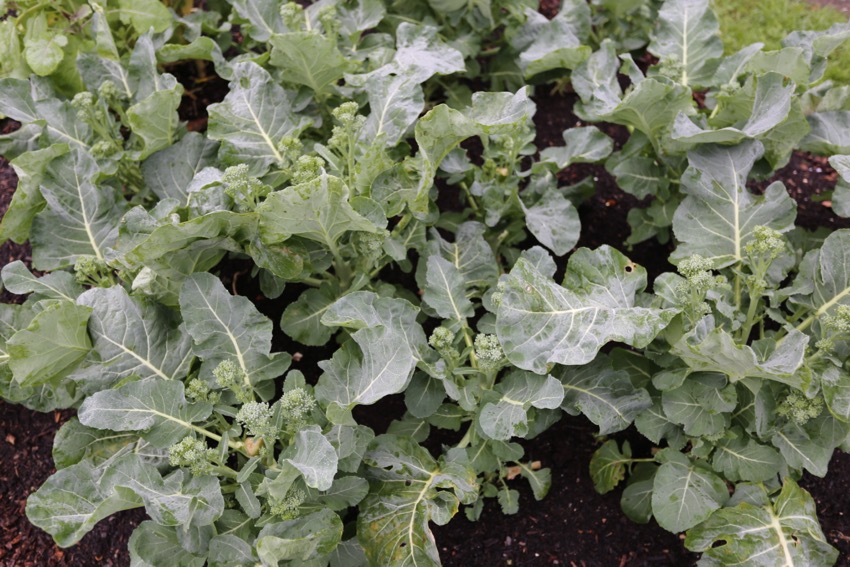
Kaibroc still brocking in mid December, third pick
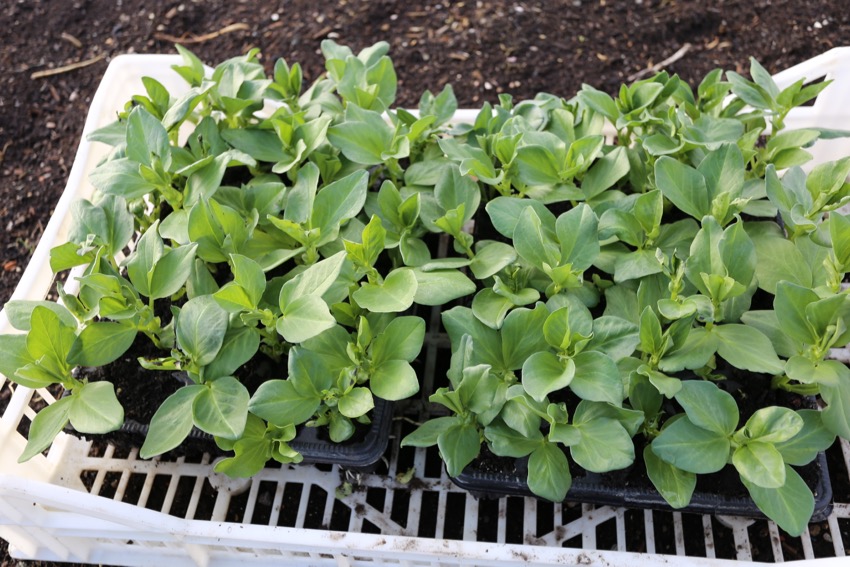
Month old seedlings of broad/fava beans are now in the ground, to crop next June
Outdoor veg
A mostly mild autumn and just enough rain (soil is still dry at lower levels) means that winter veg are looking superb. All of these photos show second crops, for example we interplant Brussels sprouts between carrots in June.
No dig makes successional cropping much easier - no soil prep and no extra feeding, just clear and plant. Keep my calendar of sowing dates on the wall to remind you next spring, summer and autumn, and invest in some propagation equipment to extend your season.
Feedback on the calendar from Derek in Lancs:
I have just received my calendar for 2019, it is absolutely brilliant: so many helpful dates and the photography is very professional
See also my interview in the Guardian about winter vegetables and how to keep supplies coming.
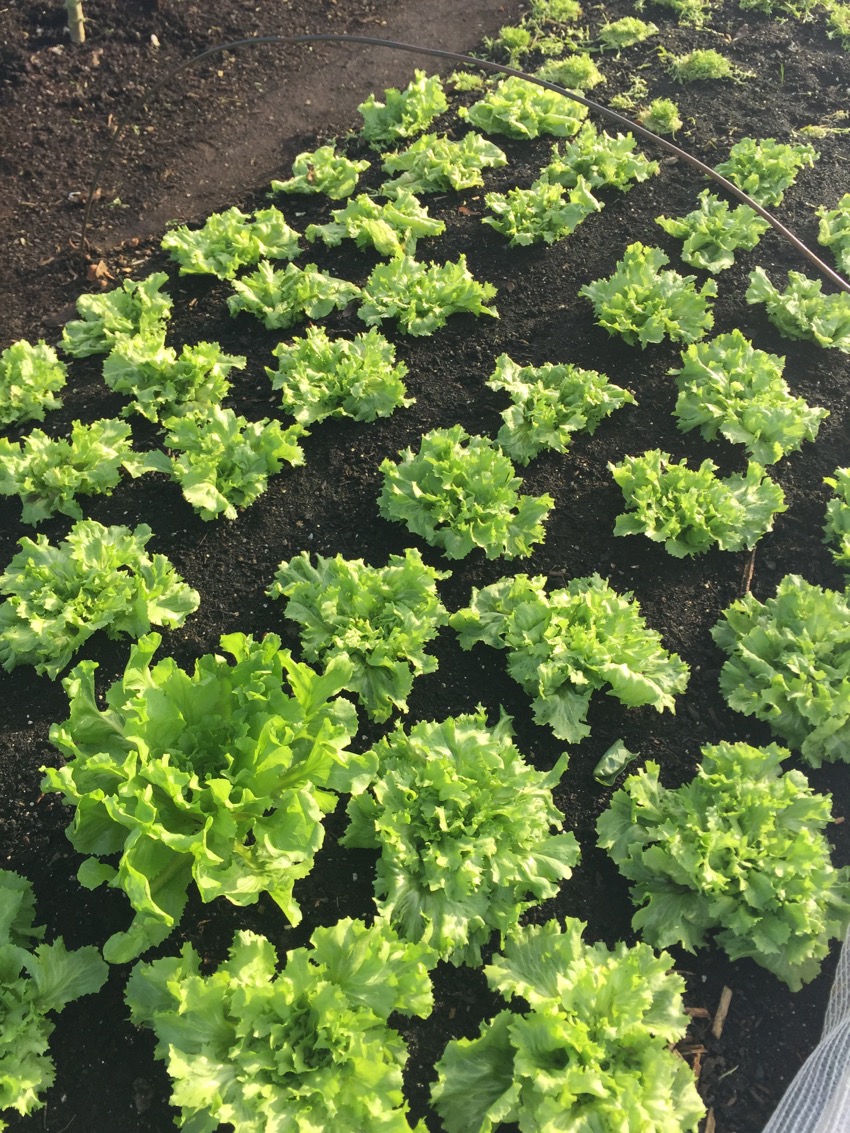
Endive Escarol Gruner (Bingenheim Seeds) is still cropping well, was planted 3rd September after we cleared courgettes, we pick the outer leaves
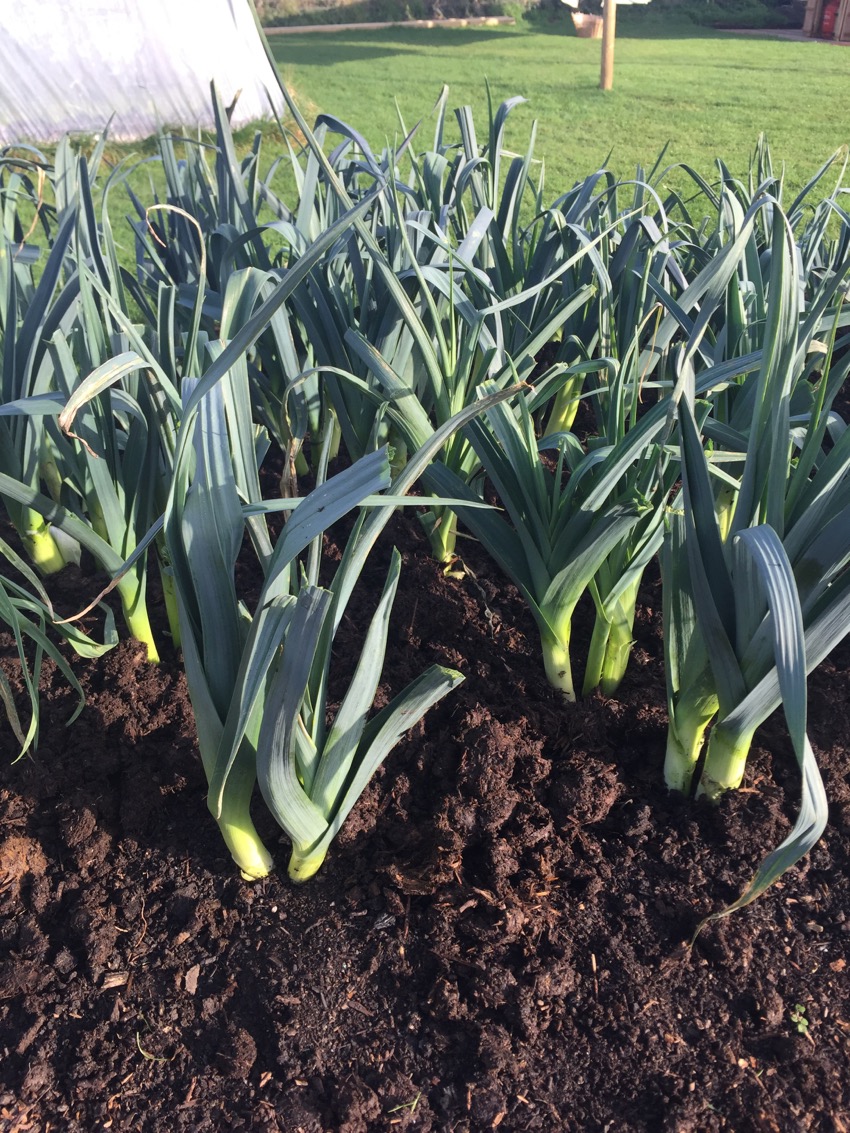
Leeks Haldor, multisown 5th April and interplanted between lettuce in August. We cleaned off the rusty leaves, to compost, then spread horse manure.
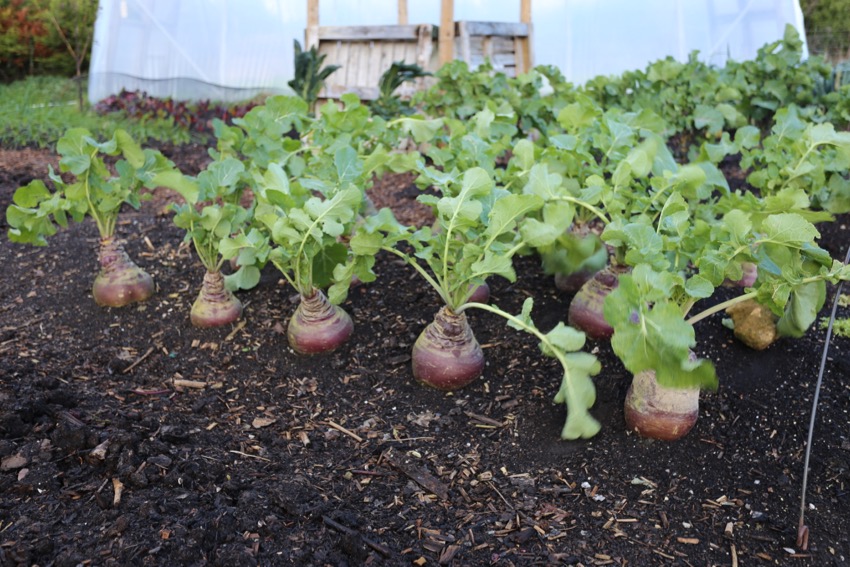
Swede Gowrie (Mr Fothergills) is second crop after chervil, sown 3.6 & planted 25.6 & no compost given since September 2017
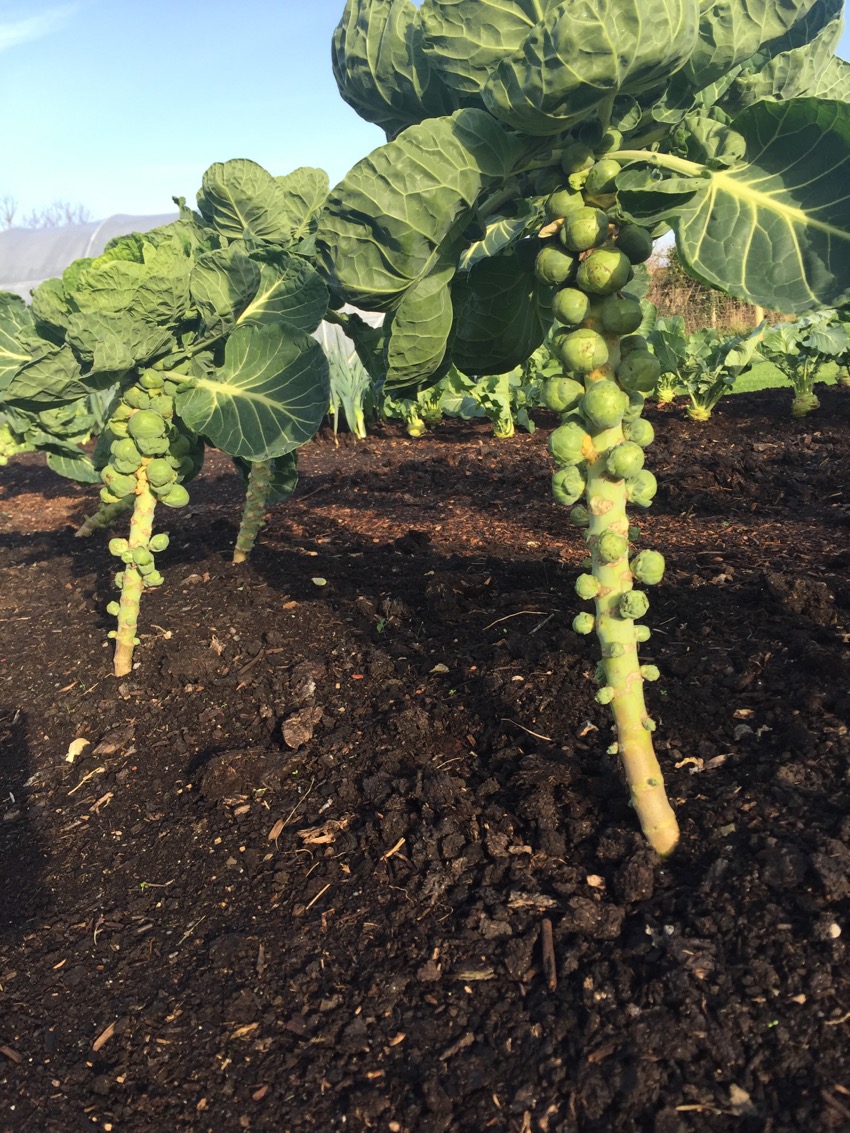
Brussels Doric F1 was planted between a first crop of carrots; we remove lower leaves to reduce pest issues
Compost making
Heaps get hot when new material is added in sufficient quantity. Small Dalek bins with occasional additions may never go above 30-40C, and in winter less.
If your compost does heap does not become hot, it will decompose more slowly and in a more fungal way, which is fine, just won’t kill weed seeds! More advice is here.
See the profile of 9 month old horse manure, and the temperature of Homeacres current heap, almost 60C since we are loading a lot of green wastes and trimmings.
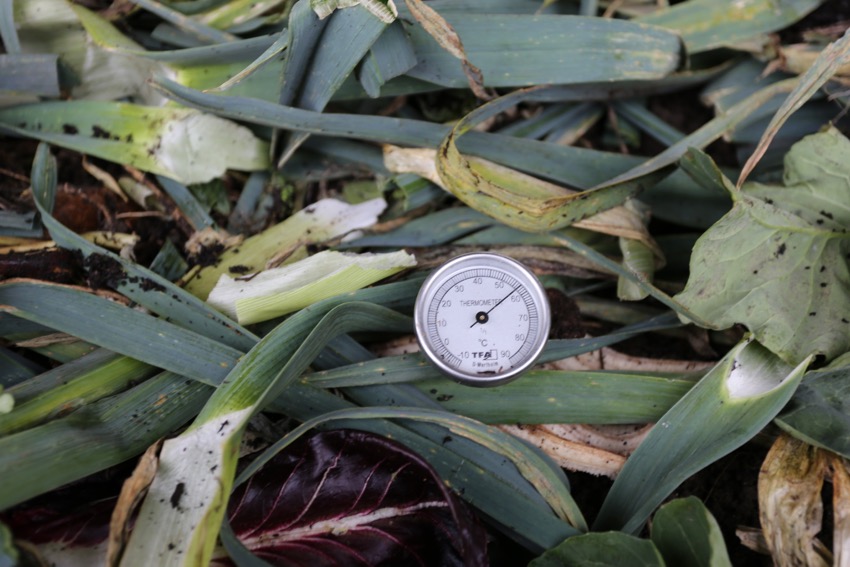
Thanks to sufficient green matter from clearing and tidying veg beds, my heap is maintaining 55-60C
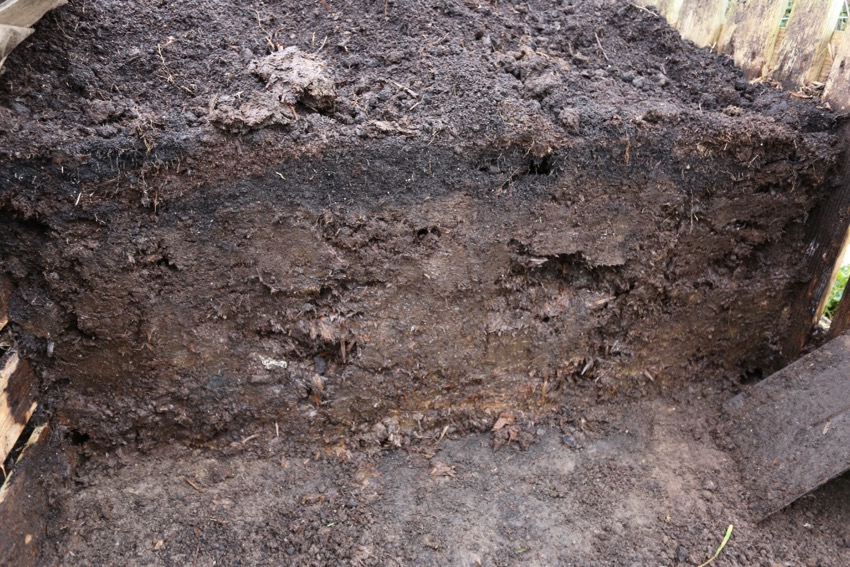
Horse manure 9 months old, started as a hotbed in the greenhouse last February, moved here May, compost on top grew aubergines
My award, and our earthworm allies
I was thrilled to receive this award at the Garden Media Guilds ceremony, feel it’s an acknowledgement of my mission to educate gardens and growers in easier and more ecological ways to grow plants. Thus to encourage more homegrown food. And to appreciate earthworms, among other wonderful organisms under our feet.
Check this paper for insights on the amazing work of earthworms, and this earthworm podcast gives similar information in a humorous way.
Recently I took an assembly and classes at Chilcompton primary school, about growing veg and making compost. The children loved it and I found it heartwarming to see their enthusiasm, plus all the great work in that direction by teachers and volunteers.

My award

With my award at the Savoy Hotel: a Wedgwood vase
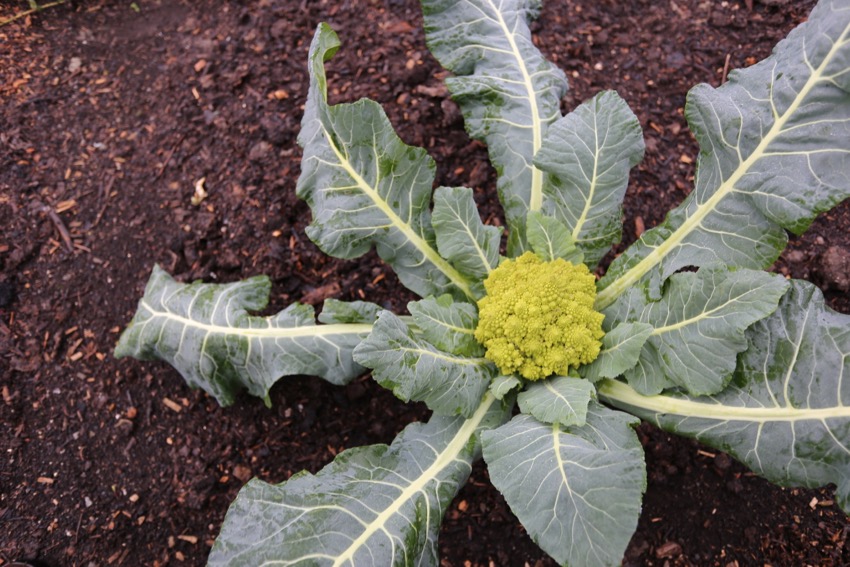
The last Romanesco, has survived light frosts and was sown in June
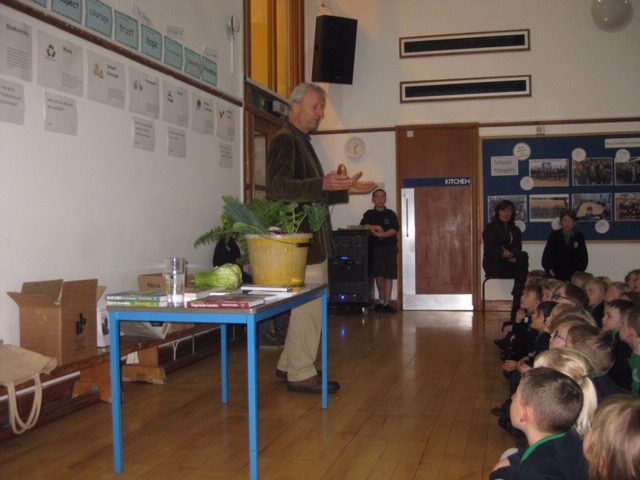
Germany and selling veg
I found it fascinating to see Germany and to meet firstly many students at Kassel University, then gardeners from all around Europe in Weinheim. The latter talk was arranged by Felix Hofmann who worked a semester here in 2016, and now runs his own no dig market garden, selling 50 CSA shares.
I heard that it’s easier to sell CSA shares in Germany, than in the UK. Here I find that vegetables are not exactly over-valued or much used, compared to many countries in mainland Europe. Felix and the guys from Krautgaart are making a living off less than an acre of land, no dig.
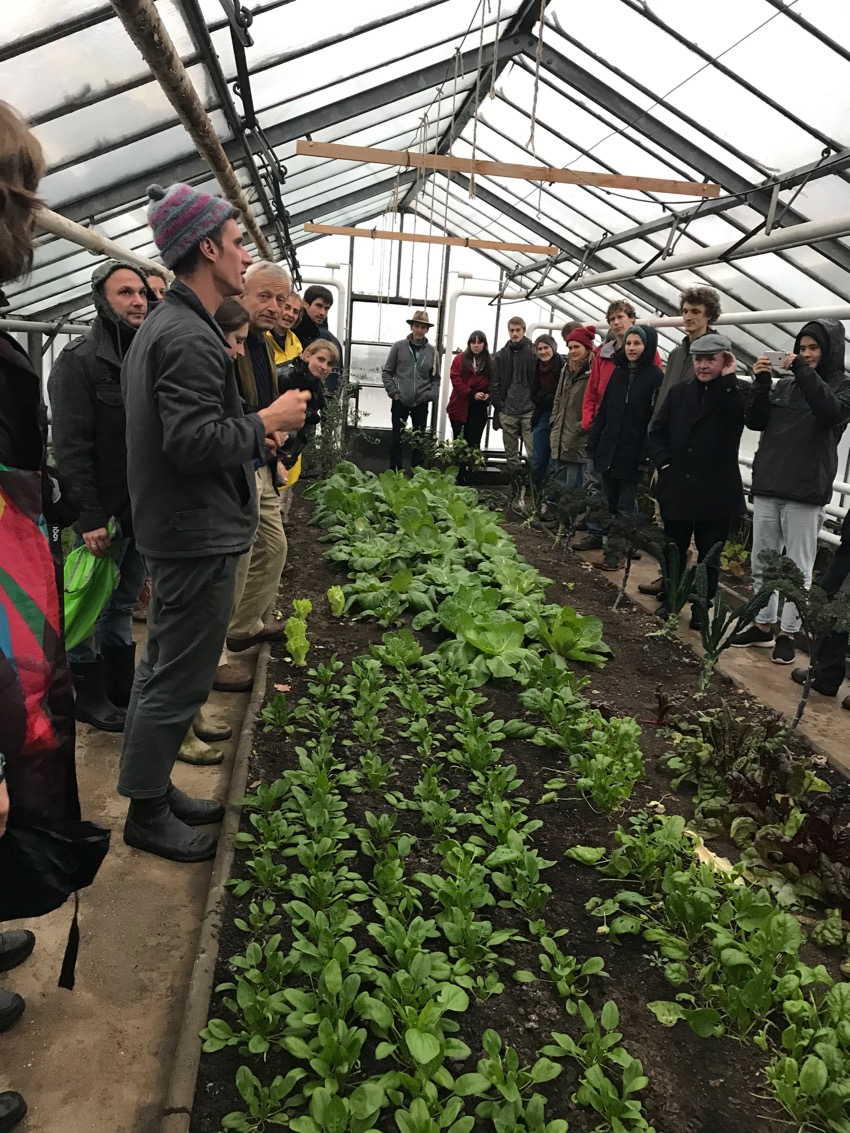
Felix left, in his greenhouse near Weinheim
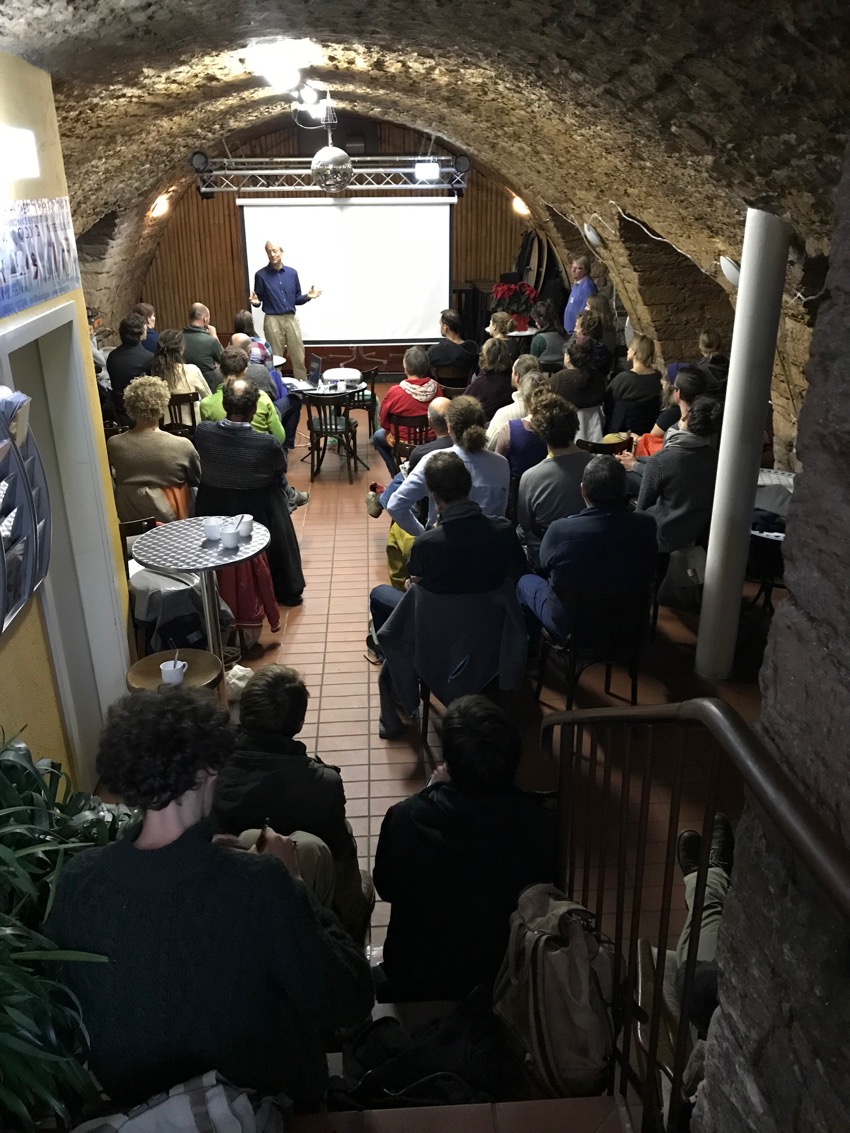
Felix left, in his greenhouse near Weinheim
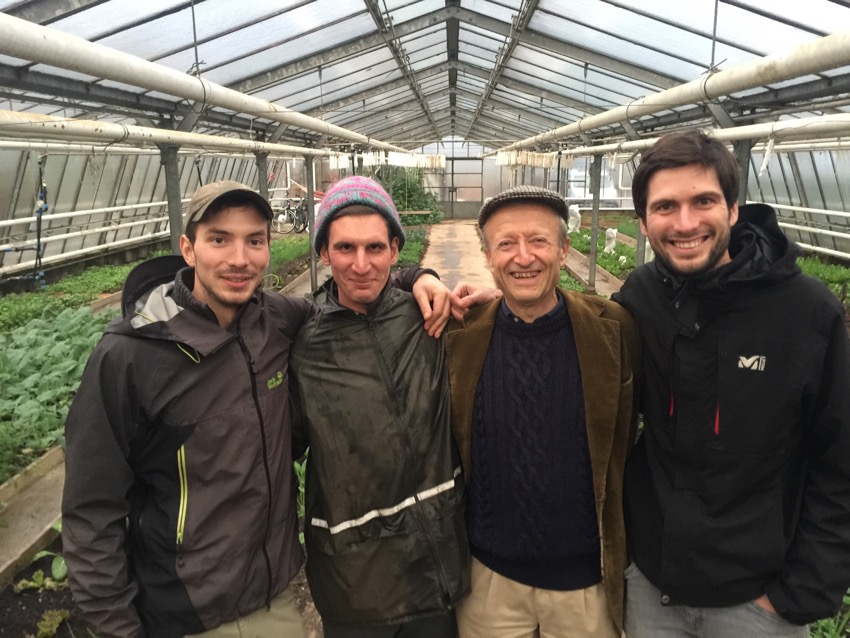
In Germany with no dig market gardeners Max left & Claude right (Krautgaart Luxembourg) and Felix Hofmann
Dark afternoons now lighter!
It’s so dark, however after 14th December the afternoons start to draw out! Mornings draw in faster until the solstice, hence the day length decreases for another week.
Steph and I have some epic picking days at this time of year: leaves are smaller so it takes longer, and orders are consistently strong. Mild weather has meant strong new growth, relative to the dark season.
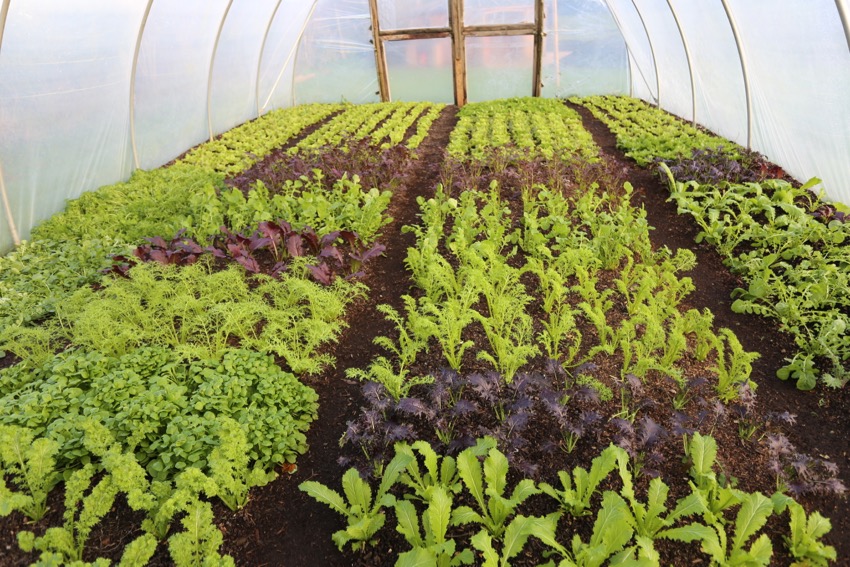
Polytunnel salad plants before 2nd pick
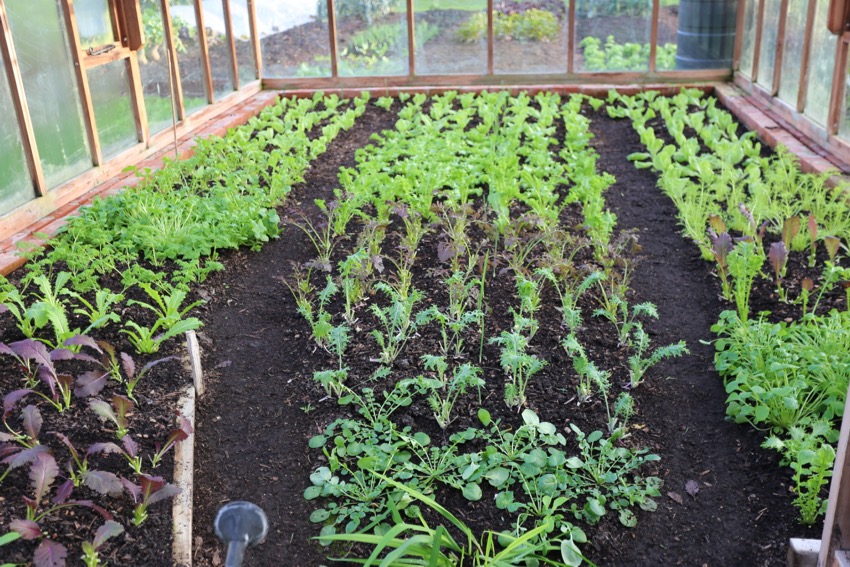
Greenhouse salad plants after second pick
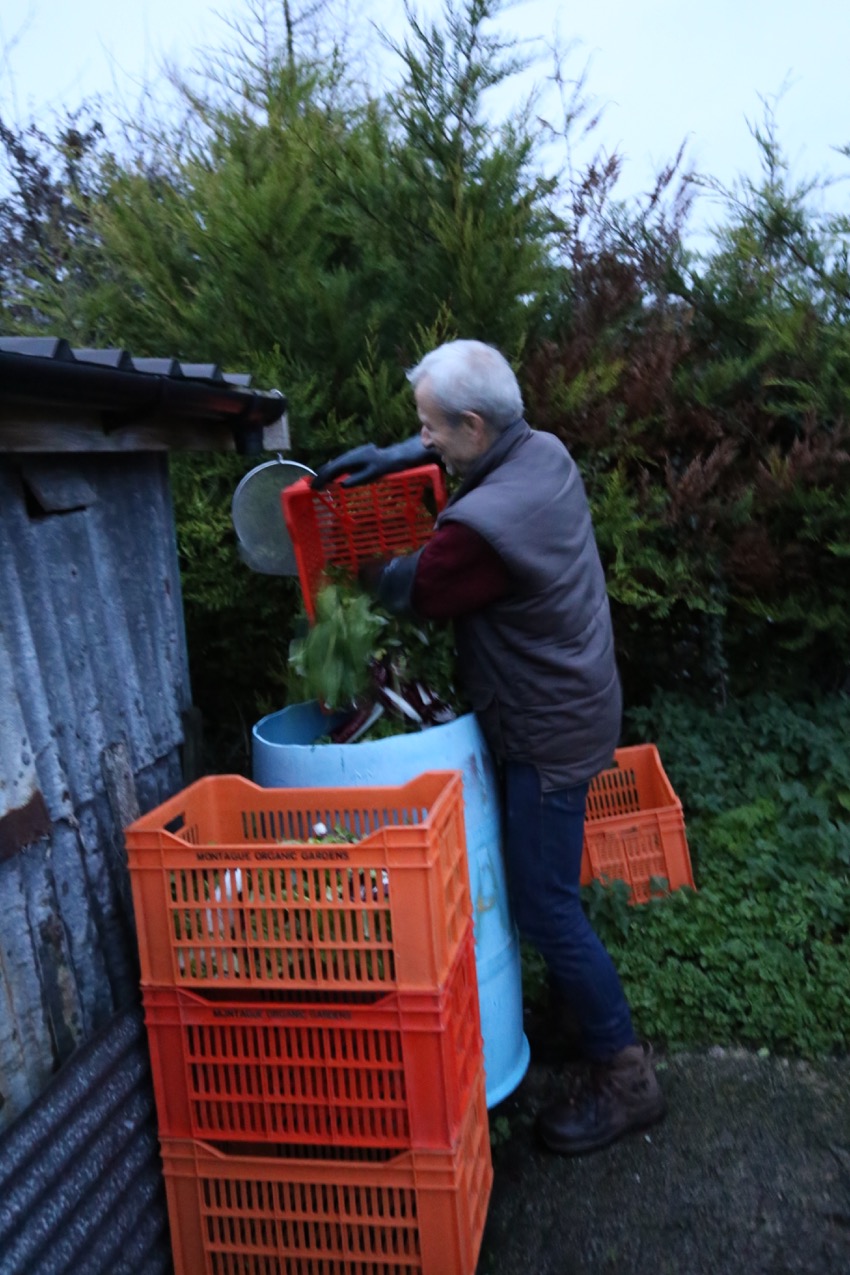
Charles washing and mixing leaves at dusk, 4.25pm
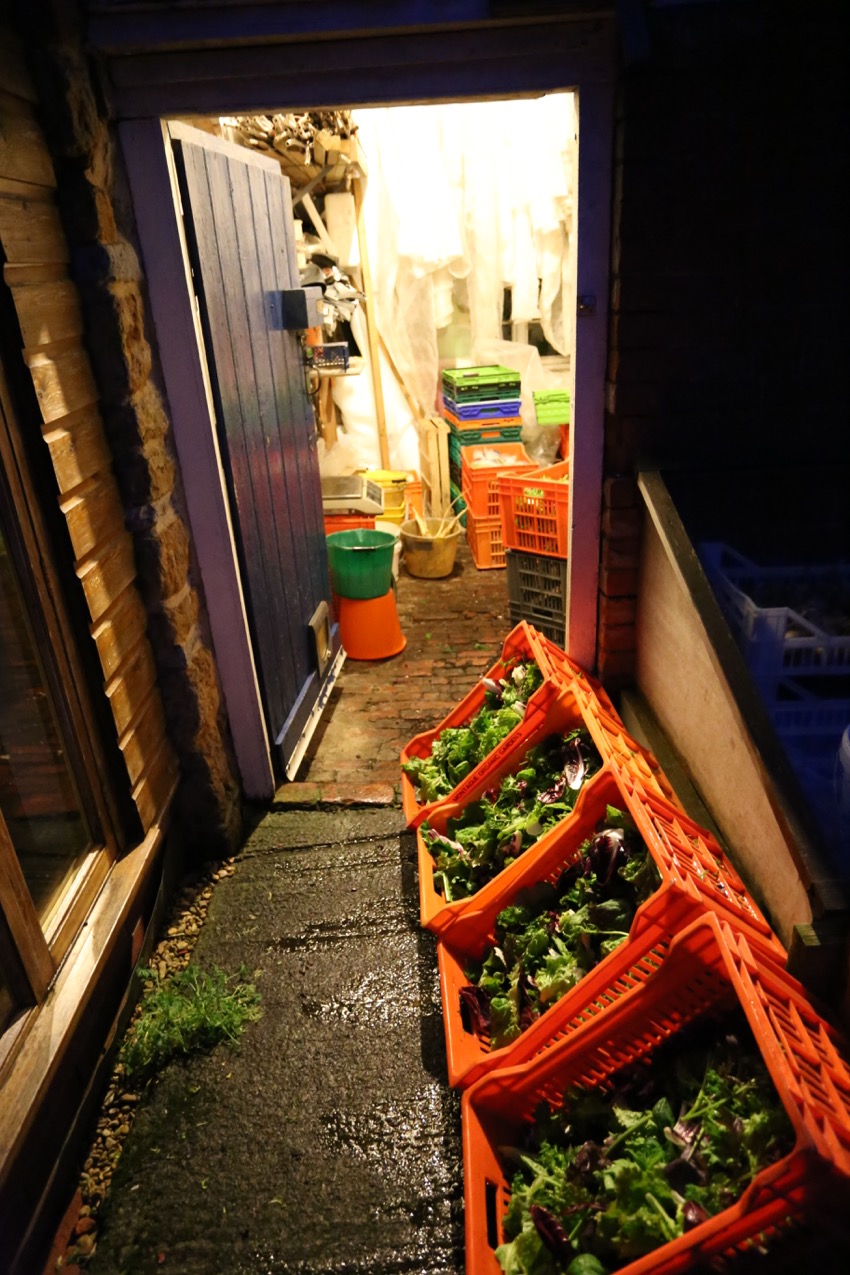
Packing leaves in the shed, Steph is in there
Courses at Homeacres
Our last course of 2018 on a windy weekend went really well, another group of fascinating people, and they sure appreciated Steph’s super food, including a spicy salad of raw parsnips and peanuts.
One thing we discussed was biodegradable packaging and I brought out two sealed salad bags which had been 11 days in the fridge. Leaves in polythene looked almost 100% fresh but the ones in a biodegradable bag were wilting.
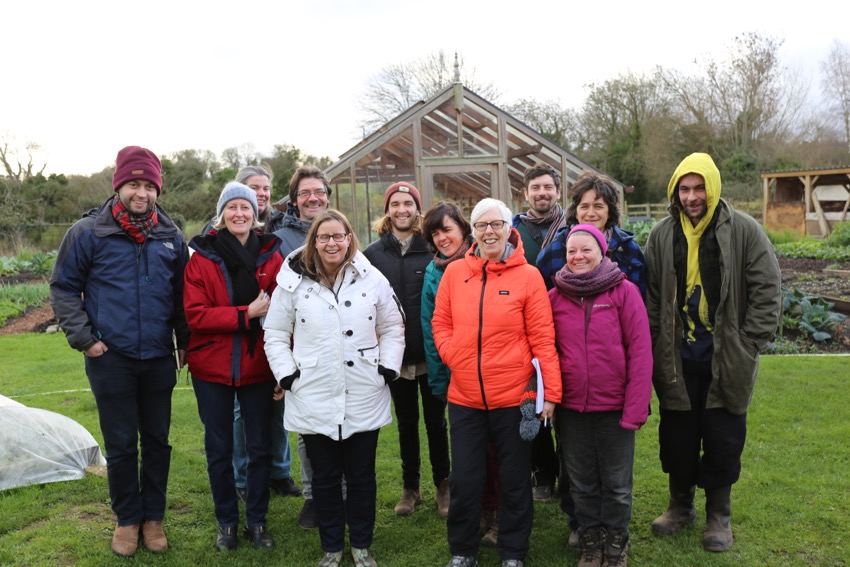
Weekend course group Homeacres December 2018
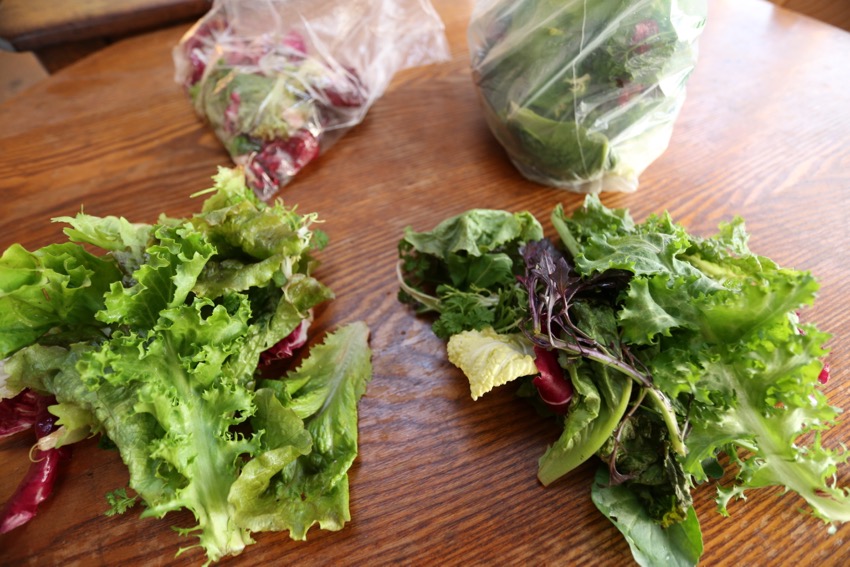
After 11 days in the fridge: leaves in polythene bad left, biodegradable bag right
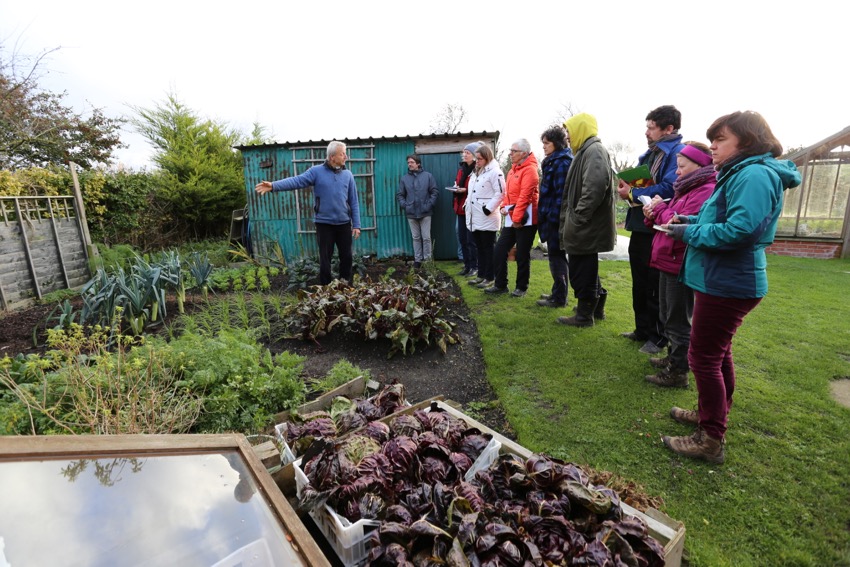
Charles teaching at Homeacres December 2018
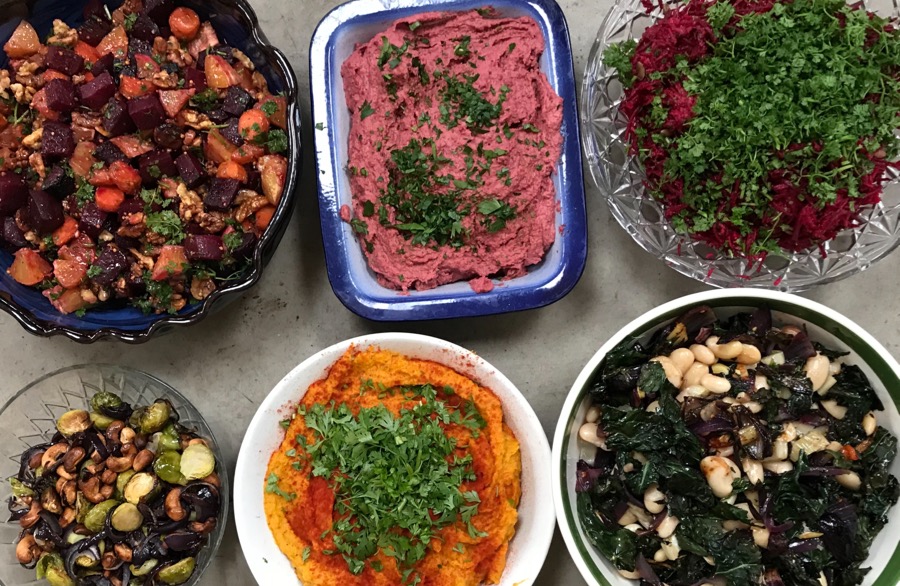
Course lunch on the Saturday and soup too, then another spread on Sunday
Various
I love coriander at this time of year: it thrives in mild winters, as does chervil.
The small garden continues to impress too.
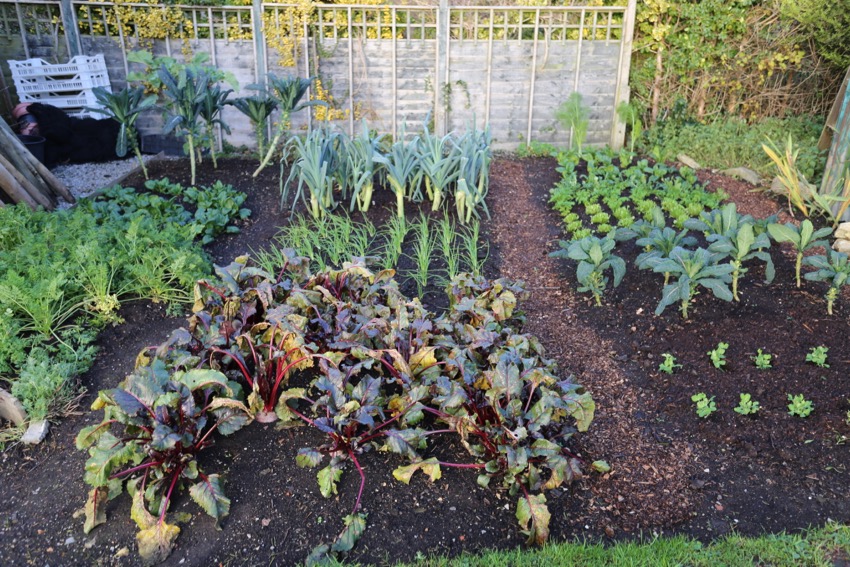
Small garden December 13th
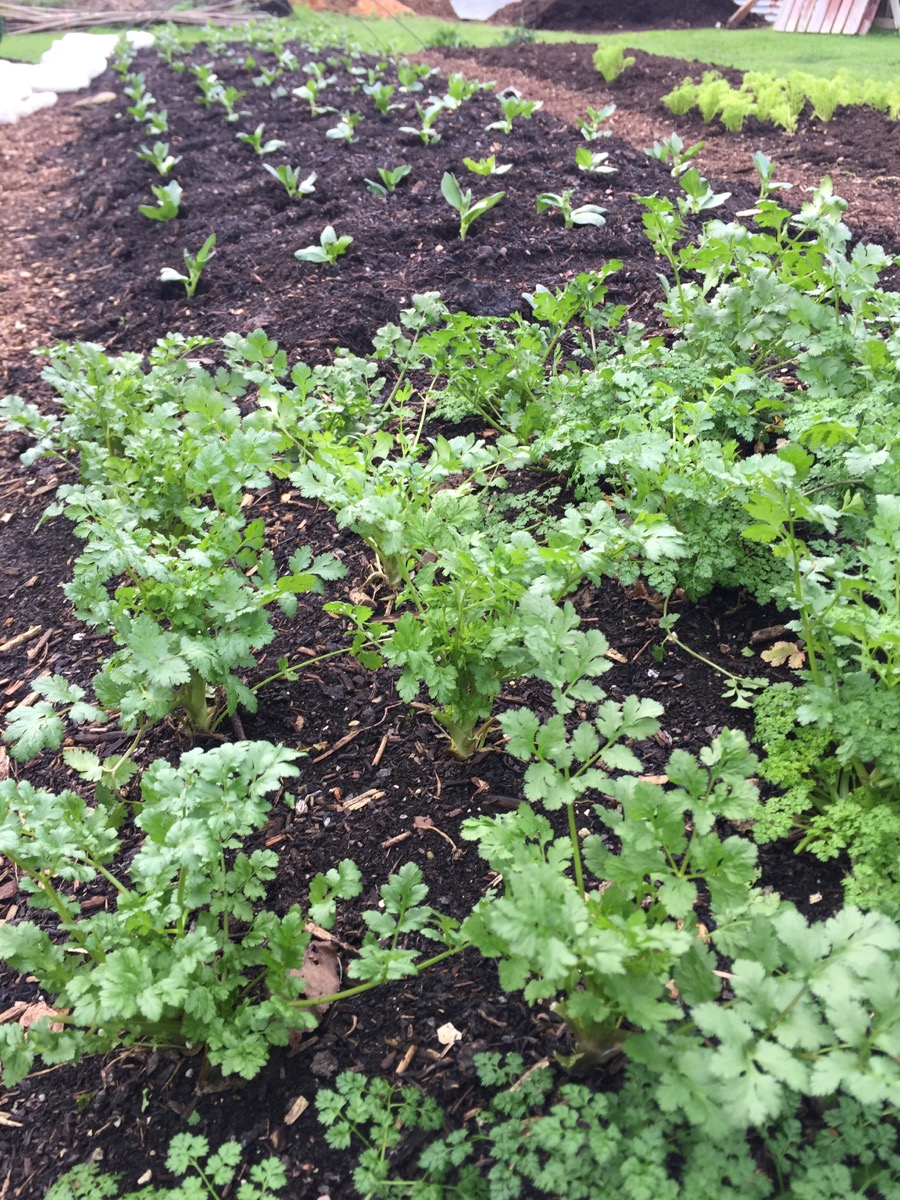
Coriander and beyond is new planting of broad beans sown 12th November
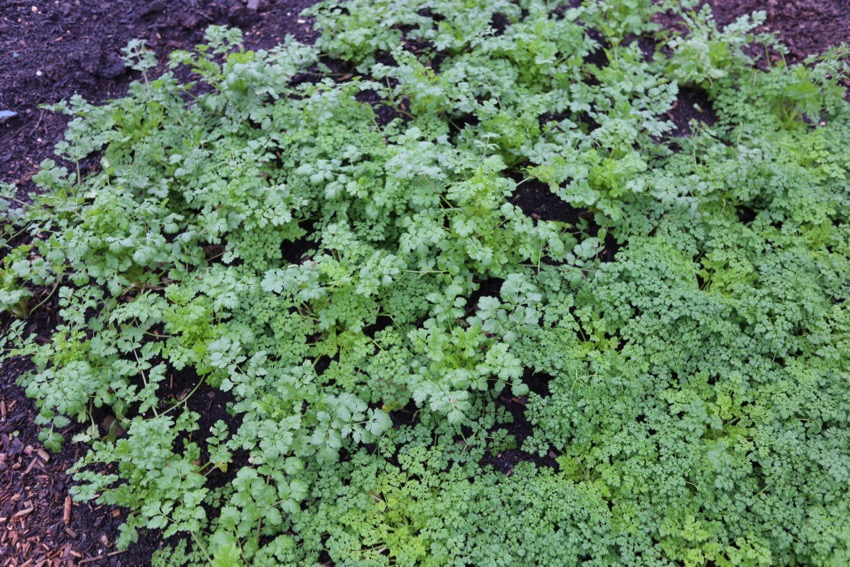
Coriander Cruiser, and chervil, planted early September
Trial beds
My least favourite job of the year is finished, digging one bed.
Trial results this year are more different than usual, and this recent video shows the remarkable differences between infiltration of water between the two beds.
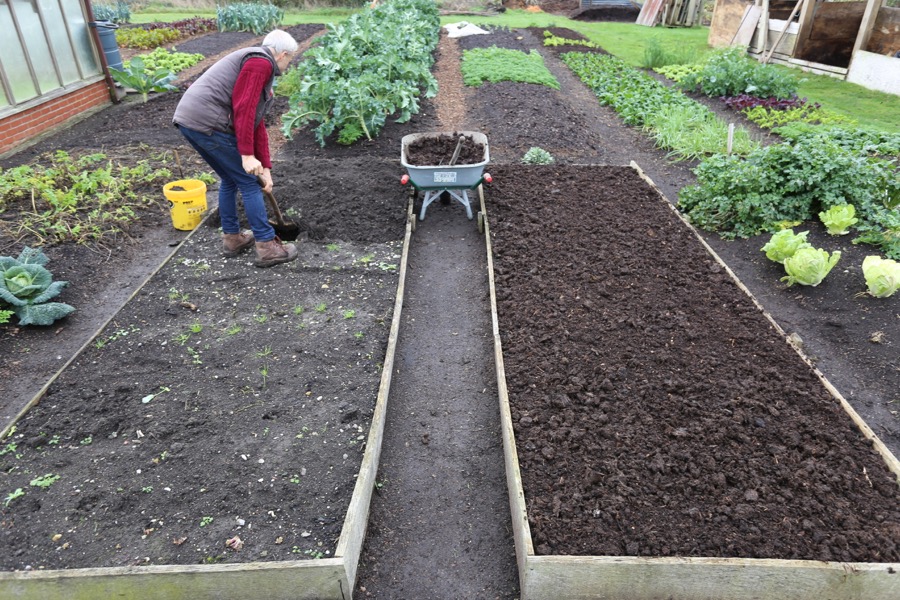
I start to dig, after making a trench whose soil is this end
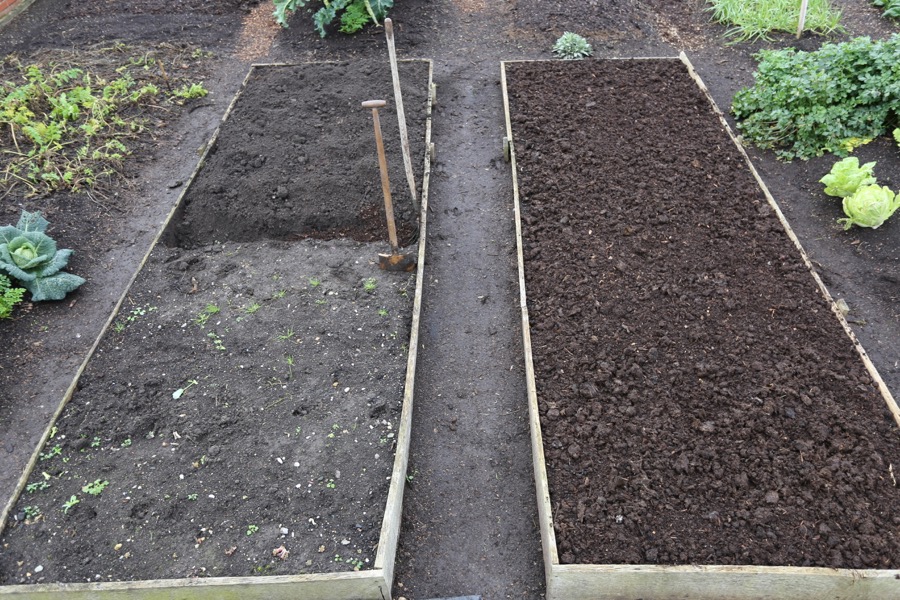
Bed half done and compost goes in the trenches, two barrows per bed
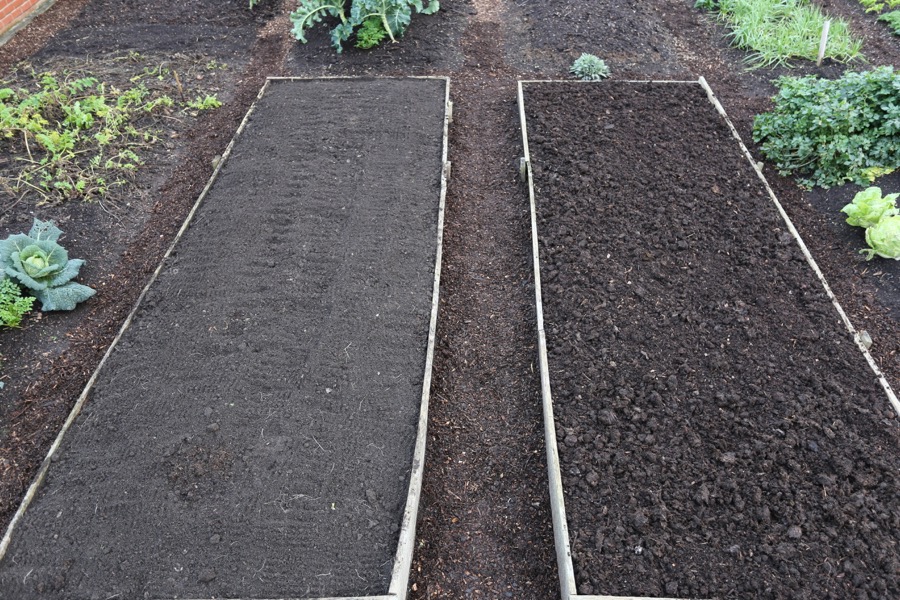
Bed on left has compost under soil, on right is same amount of compost spread on top, no dig & no forking
Chicory
Such a great vegetable for autumn and early winter: see my video for more details.
We just trimmed the last hearts which I stored with roots on for three weeks.
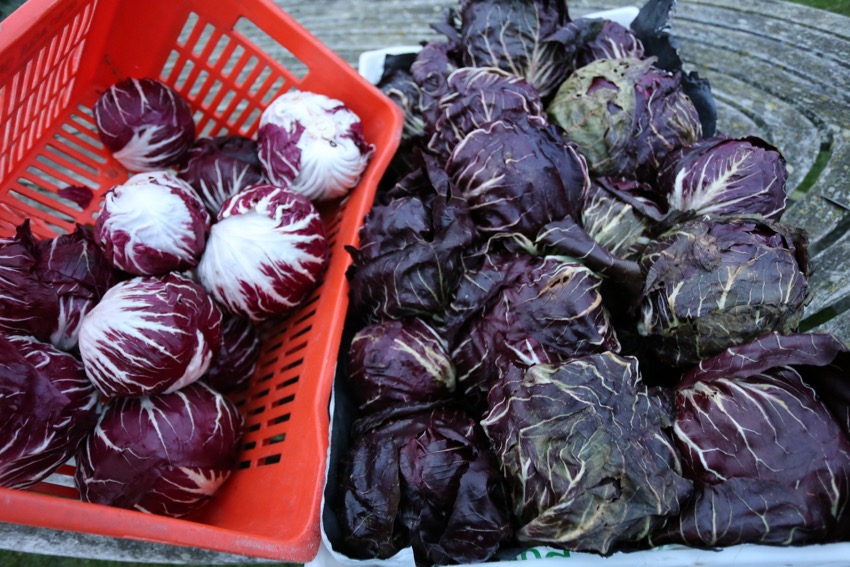
After and before trimming the hearts, gives many outer leaves for the compost heap
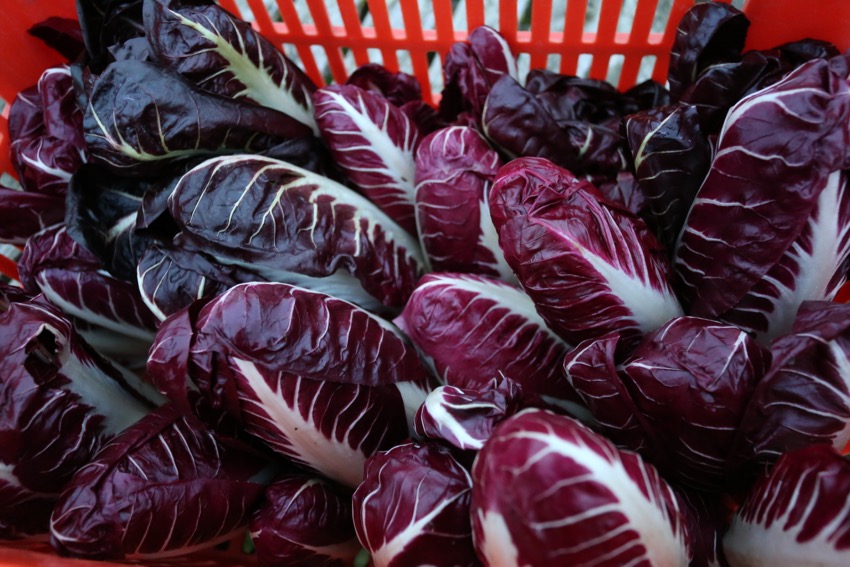
Hearts of 206TT Treviso chicory after trimming, of excellent flavour and crunchy
Celeriac and potatoes in the soil, or not
Some gardeners ask, why not just keep root veg in the ground until needed? In theory you can… but here are some pitfalls and reasons not to, depending on your soil and climate:
- pests eating them
- rots such as canker on parsnips and from septoria on celeriac
- frosts of say -4C or colder damaging roots above ground such as beetroot
- ease of access, the food is store
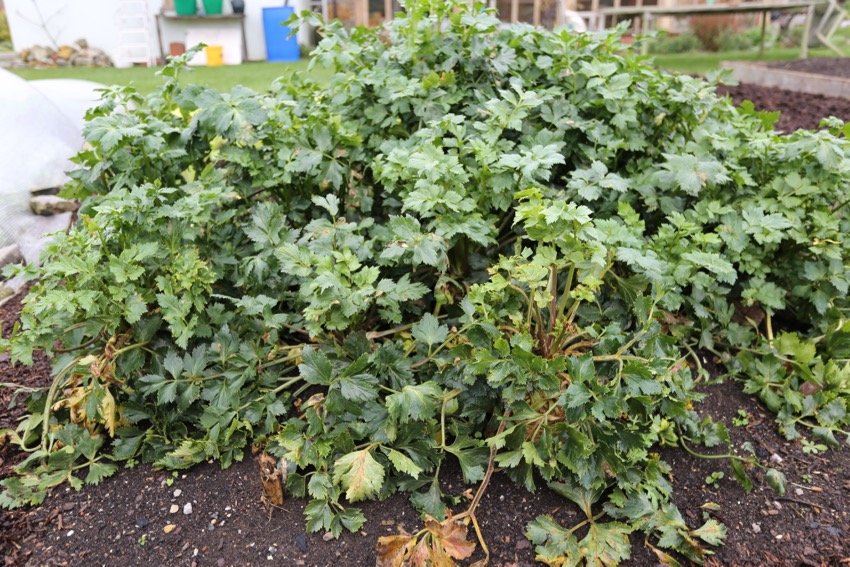
Celeriac before trimming, it’s Giant Prague sown March, planted May 20th
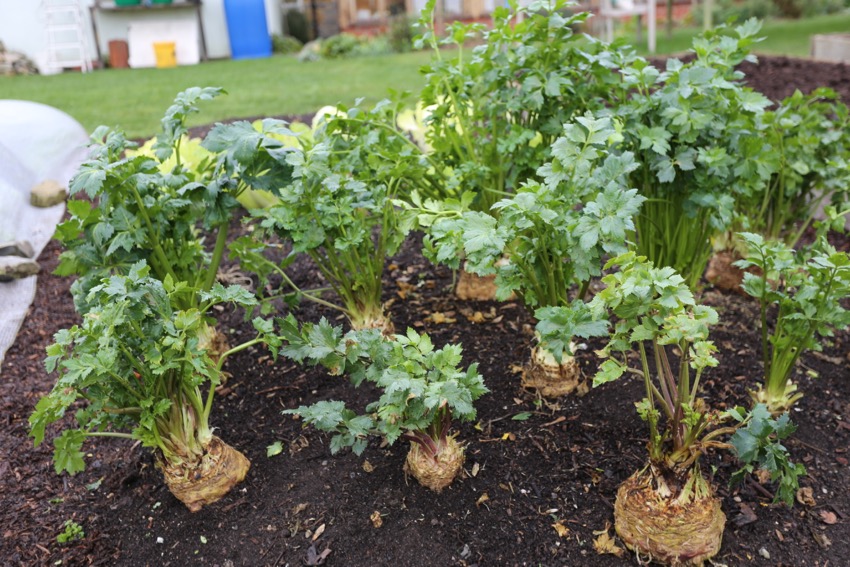
Same celeriac after trimming lower & rotting leaves
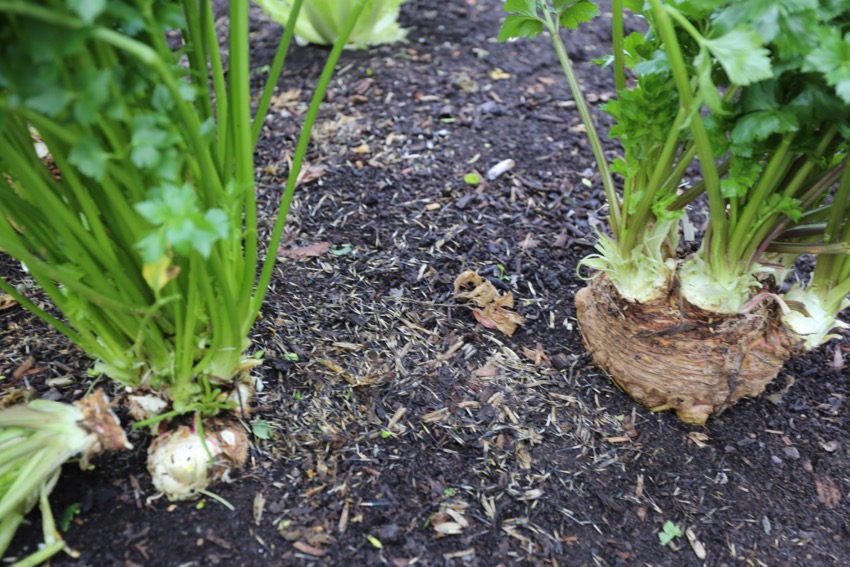
Same seed same plants same everything – but the plant on left grew many sideshoots, which I just pushed off
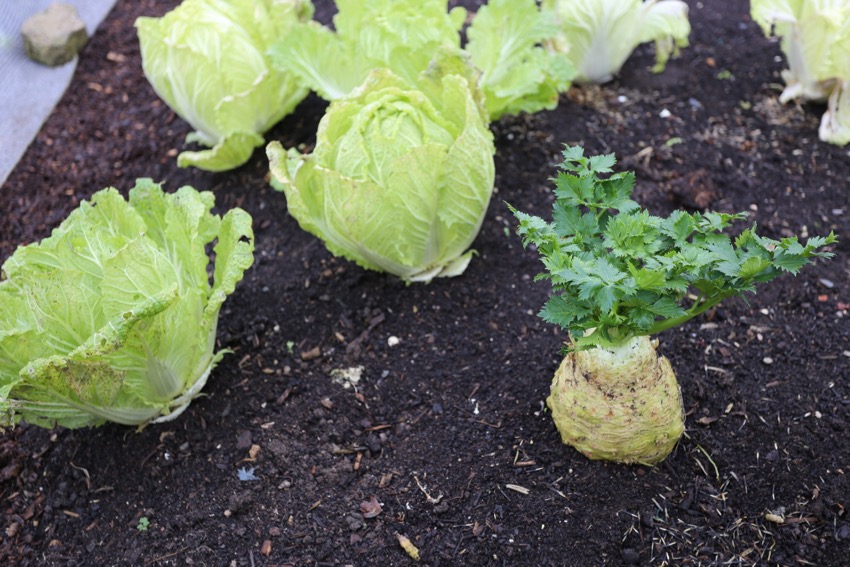
Ibis celeriac has less leaves in proportion to the bulb, nearby veg are Chinese cabbage
Clearing and mulching
Question: I am regenerating a vegetable patch in my garden. I have covered the area with a thick layer of horse manure and covered with black plastic. My question was whether i should leave the plastic over winter or remove to allow the weather?
Charles' answer: Why cover with plastic? Few weeds grow in winter + best allow water to seep through and wet the soil which is still partly dry. Maybe cover in spring if you have much bindweed… but planting is easier without it.
Finally
As the year comes to an end, here is Homeacres in December. Climate zone 8b, December mean temperature so far is 8C/46F (average 5C) and year looks to be 11.2C (average 10.5C)
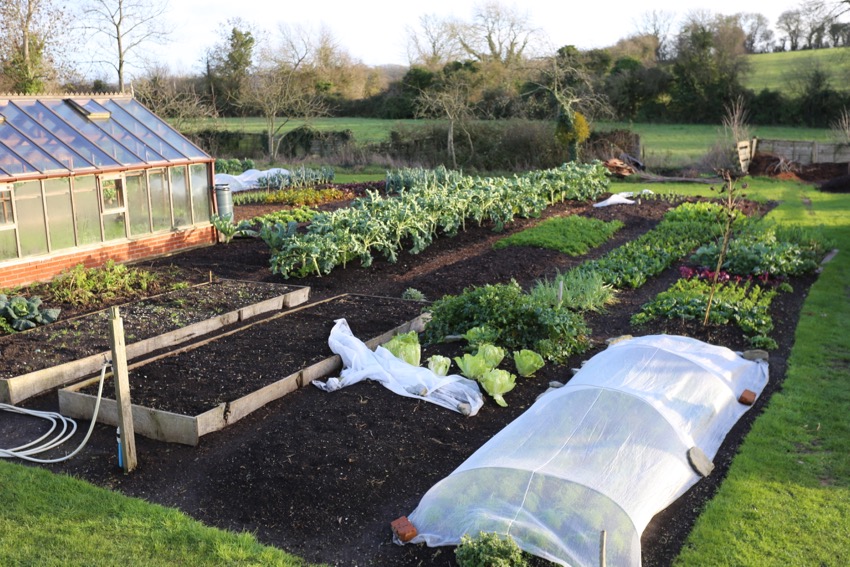
Evening view (3pm!) Homeacres no dig, 8th December
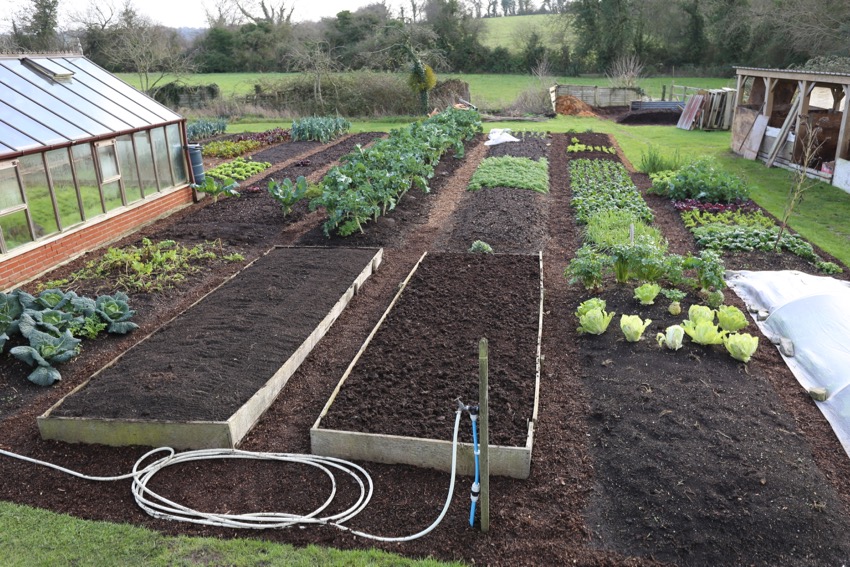
Homeacres 11th December, same view as book cover (is September)
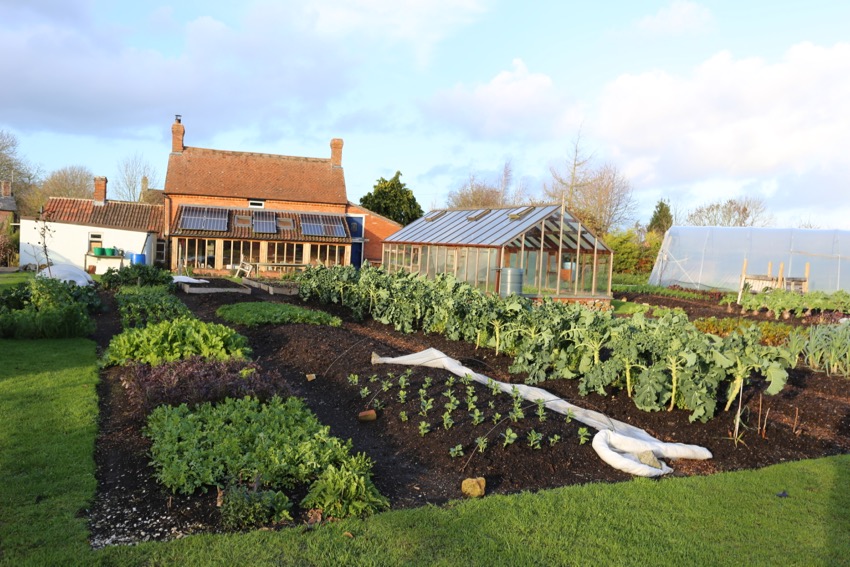
From far corner looking to the house, 9th December








































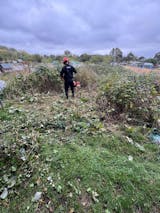
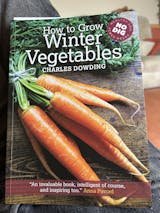
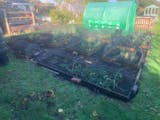
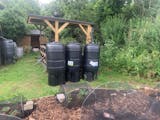
0 comments